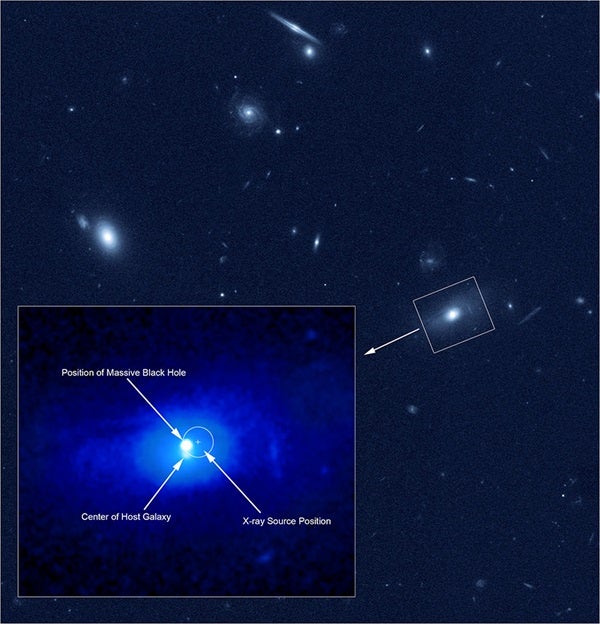You’d think a black hole with a mass of 160 million times that our Sun would be difficult to move — and you’d be right. Nonetheless, astronomers have spotted a potentially “renegade black hole” offset from the center of an elliptical galaxy about 3.9 billion light-years away.
In a paper accepted for publication in the Astrophysical Journal, first author Dongchan Kim of the National Radio Astronomy Observatory in Charlottesville, Virginia, and his colleagues outline their discovery of a supermassive black hole whose X-ray emission — a sign of growth due to the influx of new material onto the black hole — is offset from the center of its host galaxy by roughly 3,000 light-years.
The black hole, labeled CXO J101527.2+625911, wasn’t easy to find. First, the authors had to examine data from thousands of X-ray images from the Chandra X-ray Observatory to find a galaxy showing signs of an accreting supermassive black hole. They examined those candidates with the Hubble Space Telescope to look for two “peaks” of brightness in the optical images, which would indicate one of two scenarios: either a pair of accreting supermassive black holes, or a single renegade black hole ousted from the center of its galaxy.
Finally, the authors looked at Sloan Digital Sky Survey spectra of any galaxies that matched the previous two criteria. Spectra are observations that break light into its constituent parts, allowing astronomers to easily identify certain types of processes — such as accretion — and clearly identify motion.
Supermassive black holes preferentially lie in the center of their host galaxy, where they don’t move much. When one is clearly offset from the center, then, it likely means something interesting is going on. Astronomers are searching for cases such as these because they can shed further light on the formation and behavior of supermassive black holes and the galaxies in which they reside.
CXO J101527.2+625911 does indeed show both an offset and distinct motion. Its velocity doesn’t match the overall motion of its host galaxy, leading researchers to believe that it is experiencing the recoil of a previous black hole merger. When two black holes merge, they must first spiral in toward each other, each losing angular momentum before they finally collide. Because the black holes are so massive, this process generates gravitational waves. Differences in mass, spin, and orientation of the two merging black holes cause asymmetry in the gravitational waves produced, which at the final moment of merging can give the object that results a massive kick in one preferred direction. This is called recoil, and it results in a single supermassive black hole moving in a distinct direction away from the center of its galaxy.
If this scenario sounds familiar, it’s because another such case of a potentially recoiling black hole was recently reported, based on images taken with the Hubble.
Kim’s group does acknowledge that the alternate scenario is still possible: The galaxy may have two supermassive black holes, one of which (in the center) is either not growing as quickly or whose emission is shrouded. But they still favor the recoiling black hole scenario, as the host galaxy also shows signs of disruption in its outer regions and rapid new star formation, both hallmarks of a recent merger with another galaxy that increases the likelihood of a recoiling black hole.
More data will be needed, the authors say, to provide further evidence for a recoiling black hole and pin down the correct scenario.










